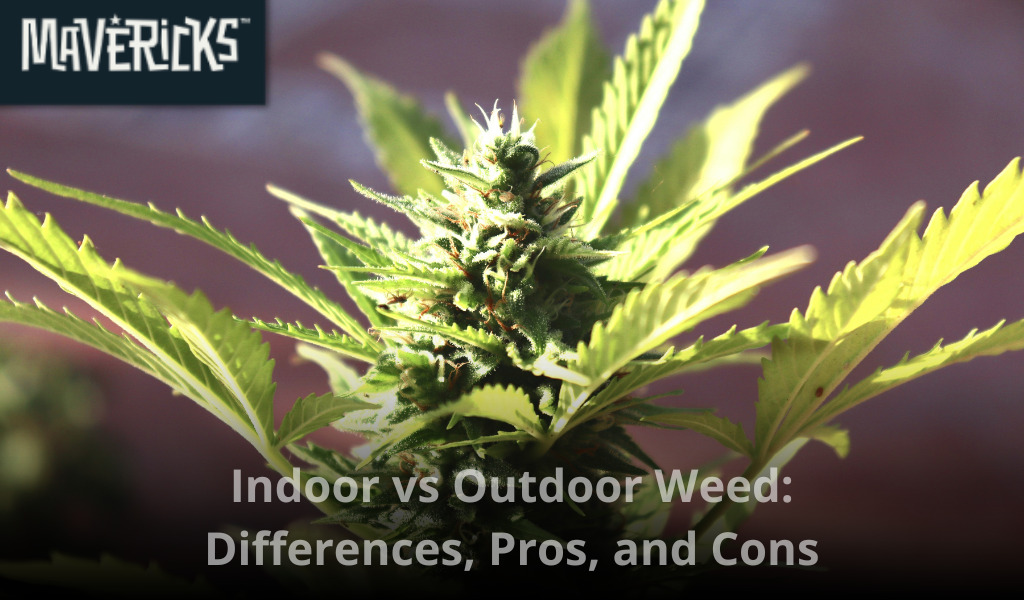Choosing between indoor and outdoor weed cultivation is one of the first decisions every grower must make. Each method offers unique benefits and challenges depending on your environment, goals, budget, and preferred strain. Whether you're growing for flower production or breeding high-quality seeds from top-tier genetics like those at Mavericks Genetics, understanding the pros and cons of indoor vs outdoor weed will help you make the right call.
In this guide, we’ll compare indoor and outdoor cannabis across multiple dimensions—quality, yield, cost, control, environmental impact, and more—so you can decide what’s best for your grow.
Key differences between indoor and outdoor weed
|
Factor |
Indoor Weed |
Outdoor Weed |
|
Light source |
Artificial (LED, HID) |
Natural sunlight |
|
Climate control |
Full control (temp, humidity) |
Depends on local weather |
|
Growing season |
Year-round |
Limited to spring–fall |
|
Yield per plant |
Moderate |
Higher with space and time |
|
Bud quality |
Denser, frostier |
Larger, airier buds |
|
Cost to grow |
High |
Low |
|
Sustainability |
High energy use |
Eco-friendly |
|
Pest risk |
Low |
Higher exposure |
Pros and cons of indoor weed
Pros
-
Maximum environmental control: Perfect temperatures, humidity, and light cycles year-round.
-
Higher potency and appearance: More trichomes, dense buds, and fewer imperfections.
-
Discreet: Ideal for urban growers or those needing privacy.
-
Less risk from pests and mold: Closed system keeps external threats minimal.
-
Multiple harvests per year: You’re not limited by seasons.
Cons
-
Expensive setup and operating costs: Lights, fans, HVAC, and space rental add up quickly.
-
Smaller yields per plant: Plants are typically shorter and trimmed to fit grow space.
-
Learning curve: Requires more technical knowledge and precise monitoring.
-
Higher carbon footprint: Due to energy-intensive equipment.
Pros and cons of outdoor weed
Pros
-
Natural sunlight = full-spectrum growth: Plants develop robust terpene and cannabinoid profiles.
-
Large yields: With room to stretch, outdoor plants can become massive.
-
Lower costs: No need for lighting or expensive climate control.
-
Sustainable and eco-friendly: Uses fewer resources overall.
-
Great for seed production: Space and isolation are ideal for breeding projects.
Cons
-
Dependent on weather: Rain, wind, frost, or drought can ruin crops.
-
Visible and less discreet: Outdoor grows may attract attention.
-
More pests and diseases: Exposure to insects, animals, and mold.
-
One harvest per year: Limited to seasonal cycles in most regions.
Indoor vs outdoor weed: Which has better quality?
Indoor-grown cannabis often looks and smells better because of precise control over lighting, humidity, and nutrients. You get:
-
Denser, more resinous buds
-
Higher THC concentrations
-
Fewer physical imperfections
However, outdoor weed has its own strengths:
-
Rich terpene profiles thanks to sunlight and natural airflow
-
A fuller, more complex aroma
-
Robust plants with deep roots and long lifecycles
Looking for elite strains suitable for both environments? Browse Mavericks Genetics USA for premium feminized seeds bred for maximum performance indoors or out.
Which is better for cannabis seed production?
Both indoor and outdoor environments can be used for cannabis seed production, but each has specific benefits:
|
Environment |
Best for... |
|
Indoor |
Controlled breeding projects, feminized seeds, reversing females with colloidal silver |
|
Outdoor |
Mass seed production, large-scale pollination, low-cost open pollination |
Outdoor space allows for more natural breeding and larger populations, while indoor spaces are better for isolating genetics and producing consistent feminized seeds.
Cost comparison: indoor vs outdoor grow
|
Expense Category |
Indoor |
Outdoor |
|
Setup cost |
$$$$ |
$ |
|
Ongoing electricity |
High |
Minimal |
|
Equipment needed |
Lights, fans, AC, dehumidifiers |
Basic tools, fencing |
|
Total yield |
Moderate |
High (weather-permitting) |
For small-scale or urban growers, indoor may be the only option. For large yields and low costs, outdoor is hard to beat—if your climate allows it.
Environmental impact
-
Indoor grow: High electricity use = bigger carbon footprint
-
Outdoor grow: Lower emissions, natural resources, better for sustainability
If reducing your ecological impact is a priority, outdoor weed wins here—especially if you're growing organically and using sustainable practices.
Which method is best for your situation?
|
Scenario |
Recommended Method |
|
Limited space or urban area |
Indoor |
|
Warm climate with long summers |
Outdoor |
|
Maximum discretion required |
Indoor |
|
Low budget |
Outdoor |
|
Growing year-round |
Indoor |
|
Large harvests with minimal cost |
Outdoor |
|
Controlled breeding and feminization |
Indoor |
Choose the grow that fits your goals
Whether you choose to grow indoors with precision or outdoors with nature, both approaches can yield top-quality cannabis when done right. Indoor grows offer control, consistency, and potency, while outdoor grows provide sustainability, size, and cost-efficiency.
At Mavericks Genetics, our feminized seeds are tested in both environments to ensure they deliver elite results wherever you grow. From powerful photoperiods to compact autos, we’ve got the genetics to fuel your next harvest—indoors or out.
Explore our latest drops now and grow like a Maverick.

Share:
How to tell when marijuana seeds are ready to harvest: A complete guide for seed maturity
Is Spinosad Safe for Cannabis Cultivation? A Grower’s Guide to Using It Right